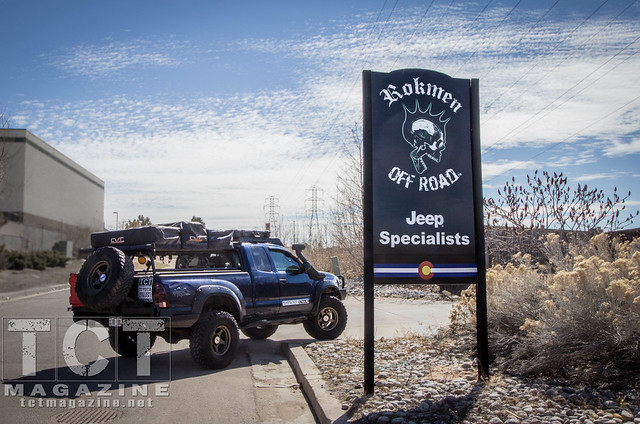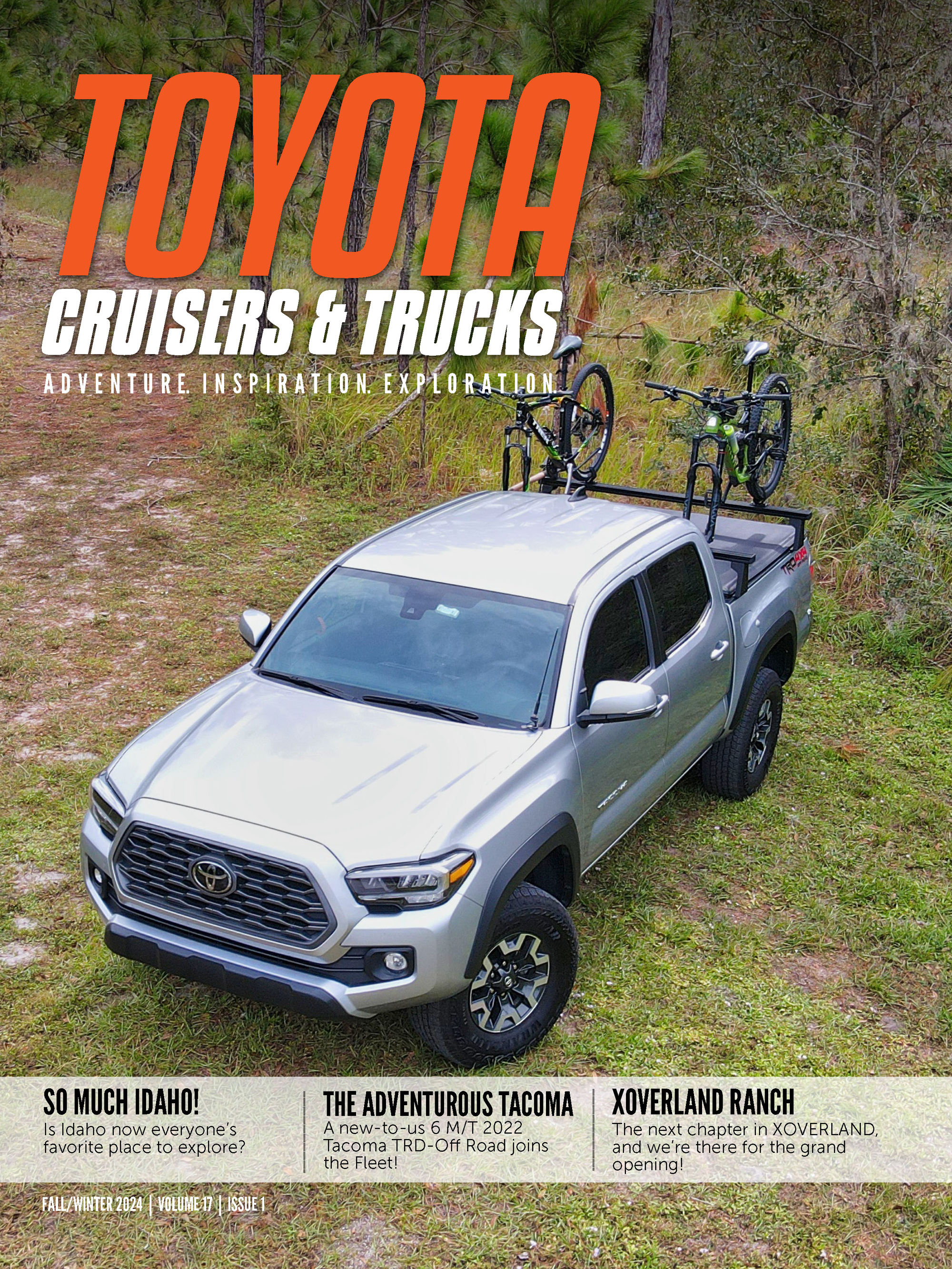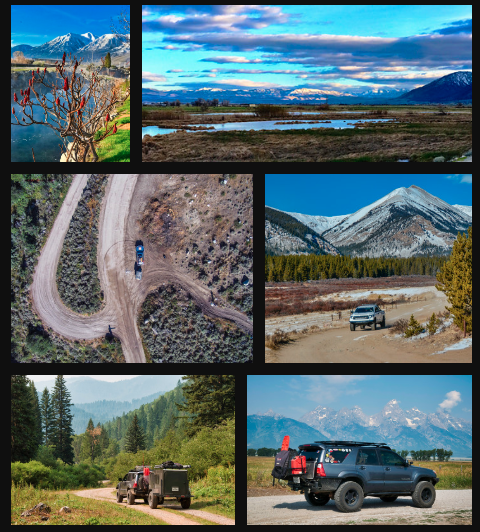April 2015 | Volume 8 | Issue 2
- Details
- By Shane Williams

Our Toyota Journey took the next step on a cold, snowy February day. I received a call from Bill Stahelin, the General Manager of Larry H. Miller Toyota Scion of Colorado Springs. The long wait for our 2015 CrewMax Tundra was finally over, the transport truck had just dropped her off at the dealership.
Ready for a surprise? This was the first Toyota vehicle we bought from a Toyota dealership, and the first brand-new Toyota our family has ever purchased. The truck had less than 50 miles on the clock when we signed that day, brand new in every way. The team at LHM took great care of our entire family, and we were in & out of the dealership in record time (less than 2 hours).
Our goal from the beginning was to spend some quality time in the Radiant Red beauty in stock form, so I could get a feel for how a fresh off the lot Tundra performed prior to starting any modifications. Of course I couldn’t NOT do anything to her, so the first mod was a new startup screen for the Entune entertainment system.
We started small in terms of spending time in the truck: A quick trip to the cabin in the mountains (about two hours each way), lumber hauling, and general around-town duties. I did take her up into the woods after some snow to test the traction control and ABS functionality. Everything performed flawlessly and it’s easy to see how many people would choose to keep their rig stock.
Less than two weeks after bringing the Tundra home, we got a little antsy for a road trip. Two quick phone calls later and plans were place to visit friends and family in New Mexico for a long weekend. We loaded up a few bags & the kids in the Tundra and headed south.
The trip to Clovis Friday, then to Carlsbad on Saturday went completely without incident. The Tundra feels at home on the interstate as well as two lane highways. The CrewMax spaciousness combined with the limited trim makes for very comfortable travel, it’s almost like rolling down the highway in your living room. Other than the overabundance of chrome on the truck, there was nothing about this part of the trip that wasn’t perfect.
We spent Saturday afternoon and evening watching the grandkids play and catching up with my family. Sunday morning was more of the same, Brenden & Alana had so much fun playing on the farm. Finally though, it was time to pack up and head north. The seven hour drive from Carlsbad to Colorado Springs is not difficult, but can be a bit boring. So we planned to stop & spend a little time at a few places along the way.
There’s a neat state park outside Roswell, NM with a cool playground so we made our way out there for a pitstop before heading north. Spending this time meant we’d hit the Colorado border after dark, but we didn’t expect any issues. A little after dinner time, we arrived in Las Vegas NM for a quick bite before getting the kids ready to pass out in the truck. Angie checked Facebook real quick and learned the news: It was snowing at home in Colorado Springs and the out-of-nowhere storm was headed south.
Our sense of urgency to get home safely quickly escalated, and we got loaded up and hit the highway. Weather and road condition checks now became a minute-by-minute affair, and we pushed the speed limit in an attempt to make it to Colorado before it got…bad.
As we made our way up Raton Pass, the snow started coming down in heaps, with wind blowing massive snow into the truck. Visibility dropped to less than 50ft in the span of a few hundred yards, and I remarked that I would turn around if I could find a safe place to do so. We were on the road with about 15 other vehicles, all now crawling up the pass at less than 30mph.
I can honestly say this is the most dangerous driving I’ve done on an interstate. In the dark, in a new truck, whiteout conditions, and still driving up a pass. Of course I switched to 4WD, but the Tundra still had stock wheels & tires, and I wasn’t sure how she would handle climbing in these conditions.
Luckily the pure whiteout only lasted a few miles, and once we reached the top of Raton Pass visibility was back up to about ¼ mile. We continued following taillights and taking our time, no need to hurry and be unsafe at this point. On the down side of Raton Pass toward Trinidad, I-25 becomes fairly curvy and while it’s not steep, in a snowstorm extreme caution has to be taken. I downshifted the Tundra using manual mode and was able to keep 100% control of the truck all the way down.
We took the first exit, found the first hotel we could, and got checked in. The only photo I was able to snap during this ordeal was after everyone was unloaded and she was parked, snug in the snow after a job well done.
To recap our first 2,000 miles in the Tundra:
- Mountain trip
- Kid hauling
- Lumber duty
- Trailer towing to the Yotas on the Beach event
- Road Trip to NM
- Dangerous mountain pass in a snowstorm
Needless to say, we’re sold on the CrewMax. In completely stock form, she performed perfectly and quite surprisingly in some very dangerous conditions. This truck has more features, comfort, power, and utility than any of our previous Toyota trucks. While she will never handle difficult trails like the FJC, and may not fit on some of our favorite exploration spots in Colorado, as an all-around multi-purpose vehicle, I don’t see how it can get any better.
At this point you may be wondering what’s next for the Tundra? Well, at just over 2,000 miles on the odometer, the modifications have begun. We’re working with the following vendors to create a one-of-a-kind Tundra, and you’ll see plenty more of her in future issues and at events around the country.
2015 CrewMax Tundra Supporting Vendors:
- Toyota Racing Development / TRD
- Toytec Lifts
- Larry H. Miller Dealerships
- Discount Tire Direct
- Ken’s Colors of Colorado Springs
- Rock Slide Engineering
- Bully Dog
- Icon Vehicle Dynamics
- Demello Off Road
[flickr set=72157651838601589]
To get your copy of the
April 2015 issue:
FIND US ON:
- Details
- By Bob Holliday

28,000 miles and countless memories later, I finally have a time to look back at my time with the Cooper Discoverer STT. With 170,000 miles now on the clock, I’ve had some great journeys with my Tacoma and have had a handful of different tires on the rig throughout that time. Not trying to sound bias on my opinion, but so far these Coopers have worked their way to the top of my list of tires.
From the factory Rugged Trail to BFG AT, then to Duratracs and finally MT/R before making the move to these STTs, I’ve had a variety of tires on the Tacoma over the years. Coming from the Duratracs and their outstanding winter handing, they had a high bar set for comparison in the winter time. The Goodyear MT/R made a great name for itself in the dirt, rocks and mud in the time I had them installed and also set a high standard in those categories. These tires, however, still had their drawbacks and kept me looking for a better overall tire to hold its own in a variety of categories and not just excelling in a few aspects.
Enter the STT into our lives. We’ve taken these tires from the streets of Denver, to the high alpine roads in the San Juans of Colorado and on many back roads throughout Colorado, New Mexico, Utah and Arizona. In every condition, I’ve seen favorable outcomes with the STT. Take that statement with a grain of salt as mentioned before, previous tires set high standards in winter and off-road conditions in my opinion.
When it comes to winter conditions, were the STTs the best? No. When it comes to off-road handling and durability? Almost. How about tread life and wear? Not really. That being said, they are nowhere near bottom of the list, far from it. In those categories, the STTs are a close 2nd in the list of tires I’ve tried on my 2006 Toyota Tacoma. With the needs I demand of my truck, I’ve been very pleased with the overall performance of these mud-terrains.
Through the rocky terrain of Colorado, their sidewall has proven their worth time and time again. They did show their mortality on a tough climb on Grizzly Lake. Angling my truck up a tough ledge, the wet rocks didn’t provide enough traction and I slid my sidewall into a nasty rock that pinched my sidewall between my FN Wheel and the rock. The tear wasn’t significant, but it did enough damage to warrant swapping out and later replacing the tire. Besides that, the STT airs down great and they still feel plenty sturdy even at 12-15psi where I typically run them. They aren’t the stickiest tire out there, but they hooked up great on a variety of off-road conditions and through all the abuse, they did not show any major signs of chunking.
Last fall, we took the truck into the backcountry of the San Rafael Swell and we saw some muddy conditions in areas near Fuller Bottom, but it didn’t take much to get the STTs and us over muddy river banks and push us effortlessly through muddy washes. On long trips like those through backcountry areas where a reliance on your equipment is crucial, I began to appreciate the comfort my STTs gave me over an assortment of terrain and weather conditions.
Having a winter under my belt with the STT, I can also say they hold their own on a variety of winter conditions. Again, are they the best? No, but they really do kick some serious butt for a mud-terrain. I’m sure if I had the tires siped, their performance on icy/hard pack would improve, but I never felt that uncomfortable with them to warrant that step.
Tread life and wear are a couple categories that I was surprised and pleased with. Coming from the MT/R right before the STT, I did not see favorable tread life in the short time I had the MT/Rs. They were great when they were off the pavement, but I daily drive my truck and see a lot of highway miles on some of our journeys. This is where the full package of the STT really comes into light. The STT comes new with 20/32nds tread depth and so far I’m still showing 11/32nds with over 28,000 miles on them. Longevity coupled with great (given not the best, but a close 2nd) off-road and all around handling, the STT has made its way to the top of my list on an overall tire standpoint.
[flickr set=72157651839236169]
To get your copy of the
April 2015 issue:
FIND US ON:
- Details
- By Jes Zaneis

The Hike
Distance to the Old Fossil Creek Dam via Flume Trail: 8 miles
Elevation change: 1280 feet
Difficulty: Moderate
Time: Allow 2-3 hours each way time to swim and explore the falls.
Water: No potable water available. Water can be filtered from the creek.
The Drive
From Phoenix:
Travel north on 1-17 to Camp Verde. Head east on AZ Highway 260 for about 7 miles to a well-marked sign for Fossil Springs Road (FS road 708). Proceed 16 miles on rough dirt road to the Irving Flume
Vehicle:
High clearance vehicle recommended. Road may be impassable during wet weather. Car possible when conditions are dry.
Seasons
Spring, Summer and Fall
Camping
Camping is free. The sites are mostly pullouts along the road. Dispersed camping along the FS road 708
Camping is allowed downstream of Fossil Creek Bridge if your camp is at least 100 feet from the edge of the creek. Camping is also allowed upstream of the Old Fossil Creek Dam
Camping is prohibited within a quarter mile either side of Fossil Creek from the Old Fossil Creek Dam downstream to Fossil Creek Bridge
Map of area and current regulations from USDA.gov:
http://www.fs.usda.gov/Internet/FSE_DOCUMENTS/stelprdb5426007.pdf
Why this hike?
Fossil Creek marks the true definition of what an asis is meant to be. This dazzling riparian springfed creek is made possible by a group of springs that pump 72degree crystal clear water to the surface at a rate of 20,000 gallons per minute.
This wide and steep canyon produces paradise at the edge of the Colorado Plateau
near the Mogollon Rim. This is one of the most diverse ecosystems in the state of Arizona. The native desert shrubs and cacti are joined by more than 30 species of trees and serve as a retreat for abundant wildlife.
The area hosts many recreational activities including hiking, backpacking, climbing, kayaking, swimming, canoeing, rafting, horse packing, bird watching, star gazing and of course the ever important solitude.
Themade this oasis one of the most unique and possibly the most abundant spring systems in the state of Arizona.
On The Trail
I arrived my campsite hours before the sun rested for the evening over the shoulders of the mountains in the Coconino National Forest. It left enough time to explore the surrounding creeks under the Fossil Springs Bridge and view the cotton candy skies that make Arizona one of the best places in the world to view a sunset.
A night of rest in the five billion star hotel that hosted some brilliant star gazing opportunities allowed for a leisurely start to the morning before heading out on the Flume trail.
Nine a.m. was a perfect time to begin the trek to the Old Fossil Creek Dam. The flume trail begins with an immediate crossing of the creek to the west side of the water. It continues up a slope along the rocky old flume road. You keep trekking along this arid high desert trail that panoramic views from 600 feet above the canyon. This route faces south and with temperatures in the summer reaching above 90 degrees it is ideal to visit in the spring or fall. The summer months bring massive amounts of people and can cause closures due to the crowds. With the water at 72 degrees it is perfectly slated for a springtime adventure.
There are several opportunities to take refuge in the shade offered by the wise old sycamores and box elders. The sun is warm enough to keep you constantly thinking about the pools this riparian oasis has to offer below. When you have that last mile to trek and you begin to constantly wipe the sweat from your brow you get a glorious glimpse of the gem below waiting for you as a bounty.
Once you drop down onto the shaded shoulders of the creek there are small travertine dams and falls all along the creek babbling and encouraging you to take a dip into the mineral laden water.
chools of chub swimming in the ponds along with the endangered Chiricahua leopard frogs and canyon tree frogs leaping into the water an example of how it should be done.
Once you arrive at the Old Fossil Creek Dam you can spend all afternoon jumping into the many pools marveling at the butterflies, damselflies and birds relaxing in the sun on a slab of rock swimming or enjoying the soothing sounds of the many
falls that all along the creek.
At some point you have to leave this oasis to its permanent inhabitants and thank them for allowing you to visit then tackle the task of the four-mile hike back to the bumpy road that leads to the hot asphalt streets of civilization.
Keep in mind during this dirt filled and reality stricken trek back that there is one last chance to splash around in this terrific sanctuary at the creek crossing where you began this tour.
There are many other incredible sights and trails in this wilderness he maximum camping allowed is 14 days. Take some time and visit the area for a day or a week just be sure you leave no trace when you do.
[flickr set=72157649932581673]
To get your copy of the
April 2015 issue:
FIND US ON:
- Details
- By Bob Holliday

To some of you, Rokmen Offroad may seem like a new name, however, these guys are anything but new to the off-road industry. Dave and Jeff have nearly 30 years of combined off-road industry experience and bring with them over a decade of high quality fabrication and knowledge to the Toyota market.
Over the years Rokmen has made a name for themselves in the Jeep market by providing high quality, high performance suspension components, armor and many other aftermarket products over a wide variety of Jeep platforms. Looking to spread their attention to detail and pursuit of providing high quality products for competitive pricing, Rokmen has begun to spread their reach into the Toyota, Dodge and Ford markets.
I had a chance recently to meet up with Dave and Jeff who are the master minds behind Rokmen Offroad to dig a bit deeper into what makes Rokmen stand out among the ever increasing crowd of aftermarket manufacturers.
Around the same time Dave’s chocolate Lab was brought into this world, Dave and Jeff gave life to Rokmen Offroad. What started with an engine swap back in 2002, Dave and Jeff have been building their business to become a successful Colorado based fab shop and nation-wide manufacturer of high quality products for a variety of vehicle manufacturers in the off-road market.
When asked why Dave and Jeff decided to make the move from their well-established place in the Jeep industry, they mentioned that the overall goal is to provide high quality products to the “average Joe,” for reasonable prices. They want to make sure that their customer, no matter the make or purpose of their vehicle, has the components necessary to build a functional and reliable rig.
Forged in Colorado, Rokmen uses 7075 aluminum, which has nearly double the tensile strength of the more common 6061 aluminum, and in turn, brings added strength to their ever expanding product line. CNC machined with quality hand polished finishes, Rokmen ensures their products don’t just look good, but also meet their high standards set after set, for every product offered. For their suspension components, Rokmen has teamed up with Currie and are utilizing Johnny Joints in their links for Jeep, FJ Cruiser and 4Runner platforms.
What sets Rokmen apart from the rest of the crowd? “Our passion is in our products.” Dave and Jeff are able to pay close attention to the details that distinguish a good product from a high quality product. “It’s the little things” Dave mentioned, that keeps him continually looking to better their products, picking apart their own products, always looking for ways in which to make them better. Their quality control allows them to offer the same high quality, time and time again, giving the customers a product they can rely on for years to come.
Even though Rokmen has been expanding greatly into the manufacturing side of the industry, they still haven’t left their roots behind. Each time I go back to their shop, they always have a full bay full of customer rigs looking to get the Rokmen touch. Dave is the mastermind behind many of the CNC productions, while Jeff works his magic on the many build projects that come in and out of the shop.
What can we expect next to come out of the Rokmen team? With the help of key partnerships around the industry like Toytec Lifts, they will continue to push themselves to provide high quality products for your next project; helping you build a functional and reliable vehicle for both on and off-road domination. With no need at this time to expand vastly, Rokmen plans to remain a small Colorado fab shop while leaving a large footprint on the market, offering high quality manufacturing for their industry partners. With their eye on creating their own shock component line, A-arms and link joints for a variety of Toyota platforms, keep an eye on these guys as they’ll be bringing some magic to the market that we’ll all want to get our hands on.
Follow Rokmen’s journey on Facebook and check out more on their company and products atwww.rokmen.com. Rokmen’s craftsmanship can also found onwww.toyteclifts.com and Toytec’s ever growing product base for our Toyota Cruisers and Trucks.
[flickr set=72157652263596575]
To get your copy of the
April 2015 issue:
FIND US ON:







